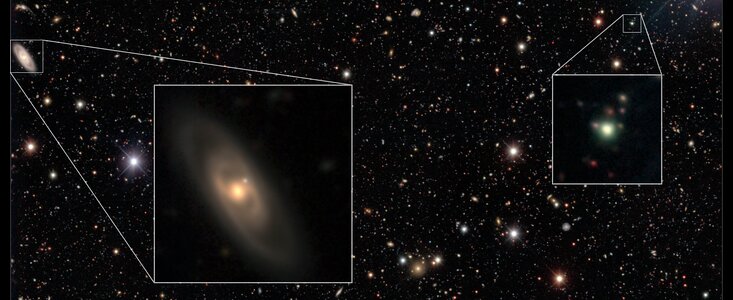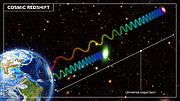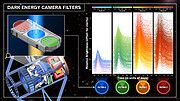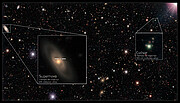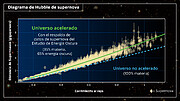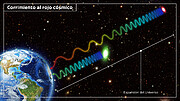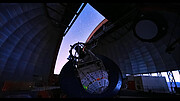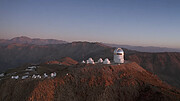Dark Energy Survey Publishes Definitive Results from Largest, Deepest, Most Uniform Supernova Sample
Dark Energy Camera at NOIRLab’s CTIO provides unique insights into the acceleration of the Universe
8 January 2024
Using the DOE-fabricated Dark Energy Camera, mounted on the Víctor M. Blanco 4-meter Telescope at Cerro Tololo Inter-American Observatory, the Dark Energy Survey has obtained the largest supernova sample ever using a single telescope. By analyzing over 1500 distant supernovae, the DES collaboration has placed the strongest constraints on the expansion of the Universe ever obtained using supernovae and found hints that the Universe’s dark energy density may vary with time.
In 1998 two separate teams of astrophysicists, using telescopes at the US National Science Foundation's Cerro Tololo Inter-American Observatory (CTIO) and Kitt Peak National Observatory, both Programs of NSF’s NOIRLab, discovered that the Universe is expanding at an accelerating rate. This phenomenon is attributed to a mysterious entity called dark energy that makes up about 70% of our Universe. The discovery came as a surprise to astrophysicists who, at the time, expected the Universe’s expansion to be slowing down.
This revolutionary discovery was achieved with observations of a particular class of exploding stars, called type Ia (read “type one-A”) supernovae [1], and was recognized with the Nobel Prize in Physics in 2011.
Now, 25 years after the initial discovery, the scientists working on the Dark Energy Survey (DES) have released the results of an unprecedented analysis using the same technique to further probe the mysteries of dark energy and place the strongest constraints on the expansion history of the Universe ever obtained. In a presentation at the 243rd meeting of the American Astronomical Society on 8 January 2024, and in a paper submitted to the Astrophysical Journal, astrophysicists report results that are consistent with the now-standard cosmological model of a Universe with an accelerating expansion. Yet, the findings are not definitive enough to rule out a possibly more complex model.
The DES is an international collaboration comprising more than 400 scientists from over 25 institutions, led by the US Department of Energy’s Fermi National Accelerator Laboratory. The DES employs the Dark Energy Camera (DECam), a 570-megapixel digital camera built by Fermilab and funded by the DOE Office of Science, with significant contributions by the NSF and the DES partners. It is mounted on the Víctor M. Blanco Telescope at CTIO in Chile. By taking data on 758 nights across six years, DES scientists mapped an area almost one-eighth of the entire sky.
Among the observations of about two million distant galaxies, the DES team found several thousand supernovae, making this the largest, deepest supernova sample ever obtained from a single telescope [2]. DES researchers then used advanced machine-learning techniques to aid in supernova classification and sift the sample into a uniform high-quality dataset with 1499 likely type Ia supernovae, thereby tripling the number of observed supernova Ia beyond a redshift of 0.2 and quintupling the number beyond a redshift of 0.5 [3]. “It’s a really massive scale-up from 25 years ago when only 52 supernovae were used to infer dark energy,” said Tamara Davis, a professor at the University of Queensland in Australia and co-convener of the DES Supernova Working Group.
This large sample of supernovae, spanning a wide range of distances, can be used to trace out the history of cosmic expansion. For each supernova, DES scientists combine its distance with a measurement of its redshift — how quickly it is moving away from Earth as a result of the expansion of the Universe. Together, these two factors can lend insight into whether the Universe’s dark energy density has remained constant or changed over time.
“As the Universe expands, the matter density goes down,” said DES director and spokesperson Rich Kron, who is a Fermilab and University of Chicago scientist. “But if the dark energy density is a constant, that means the total proportion of dark energy must be increasing as the volume increases.”
The standard cosmological model is known as ΛCDM, or ‘Lambda cold dark matter’. This mathematical model describes how the Universe evolves using just a few features such as the density of matter, the type of matter and the behavior of dark energy. While ΛCDM assumes the density of dark energy in the Universe is constant over cosmic time and doesn’t dilute as the Universe expands, the DES Supernova Survey results hint that this may not be true.
Results were obtained by combining the DES data with complementary data from the European Space Agency’s Planck telescope. An intriguing outcome of this survey is that it is the first time that enough distant supernovae have been measured to make a highly detailed measurement of the decelerating phase of the Universe, and to see where the Universe transitions from decelerating to accelerating. And while the results are consistent with a constant density of dark energy in the Universe, they also hint that dark energy might possibly be varying. “There are tantalizing hints that dark energy changes with time,” said Davis, “We find that the simplest model of dark energy — ΛCDM — is not the best fit. It’s not so far off that we’ve ruled it out, but in the quest to understand what is accelerating the expansion of the Universe this is an intriguing new piece of the puzzle. A more complex explanation might be needed.”
The innovative techniques that the DES has pioneered will shape and further drive future astrophysical analyses. Projects like the upcoming Legacy Survey of Space and Time, to be conducted by Vera C. Rubin Observatory, which is operated jointly by NSF’s NOIRLab and DOE’s SLAC National Accelerator Laboratory, as well as NASA’s Nancy Grace Roman Space Telescope, will pick up where the DES left off. “We’re pioneering techniques that will be directly beneficial for the next generation of supernova surveys,” said Kron.
"This result clearly shows the value of astronomical survey projects that continue to yield excellent science well after data collection has ended," says Nigel Sharp, a program director in NSF's Astronomical Sciences Division. "We need as many diverse approaches as we can get in order to understand what dark energy is, and what it isn’t. This is an important route to that understanding."
Alistair Walker, DECam Instrument Scientist at NOIRLab, adds, “Multiple elements came together to permit this important advance in our understanding of dark energy — the pristine skies of Chile, the large Blanco Telescope equipped with the superbly-made DECam, intensive data calibration efforts that achieved unprecedented levels of measurement accuracy and a decade of analysis effort by a very talented group of scientists.”
Notes
[1] This technique requires data from type Ia supernovae, which occur when an extremely dense dead star, known as a white dwarf, reaches a critical mass and explodes. That critical mass is nearly the same for all white dwarfs, so all type Ia supernovae have approximately the same actual brightness. By comparing the apparent brightnesses of two type Ia supernovae as seen from Earth astronomers can determine their relative distances from us.
[2] The recently published Union3 dataset from Rubin et al. (2023) analyzes 2087 supernovae from different telescopes; the DES survey data were all captured using the same telescope, thereby making the sample more uniform and highly precise.
[3] An object’s redshift tells astronomers how quickly it is moving away from Earth as a result of the expansion of the Universe.
More information
This research was presented in a paper submitted to the Astrophysical Journal titled, "The Dark Energy Survey: Cosmology Results With ~1500 New High-redshift Type Ia Supernovae Using The Full 5-year Dataset”
These results are presented by the DES Supernova Working Group and the DES Collaboration.
NSF’s NOIRLab (National Optical-Infrared Astronomy Research Laboratory), the US center for ground-based optical-infrared astronomy, operates the International Gemini Observatory (a facility of NSF, NRC–Canada, ANID–Chile, MCTIC–Brazil, MINCyT–Argentina, and KASI–Republic of Korea), Kitt Peak National Observatory (KPNO), Cerro Tololo Inter-American Observatory (CTIO), the Community Science and Data Center (CSDC), and Vera C. Rubin Observatory (operated in cooperation with the Department of Energy’s SLAC National Accelerator Laboratory). It is managed by the Association of Universities for Research in Astronomy (AURA) under a cooperative agreement with NSF and is headquartered in Tucson, Arizona. The astronomical community is honored to have the opportunity to conduct astronomical research on Iolkam Du’ag (Kitt Peak) in Arizona, on Maunakea in Hawai‘i, and on Cerro Tololo and Cerro Pachón in Chile. We recognize and acknowledge the very significant cultural role and reverence that these sites have to the Tohono O’odham Nation, to the Native Hawaiian community, and to the local communities in Chile, respectively.
Funding for the DES Projects has been provided by the US Department of Energy, the US National Science Foundation, the Ministry of Science and Education of Spain, the Science and Technology Facilities Council of the United Kingdom, the Higher Education Funding Council for England, the National Center for Supercomputing Applications at the University of Illinois at Urbana-Champaign, the Kavli Institute of Cosmological Physics at the University of Chicago, Funding Authority for Funding and Projects in Brazil, Carlos Chagas Filho Foundation for Research Support of the State of Rio de Janeiro, Brazilian National Council for Scientific and Technological Development and the Ministry of Science and Technology, the German Research Foundation and the collaborating institutions in the Dark Energy Survey.
Based in part on data acquired at the Anglo-Australian Telescope for the Dark Energy Survey by OzDES. We acknowledge the traditional custodians of the land on which the AAT stands, the Gamilaraay people, and pay our respects to elders past and present.
Fermilab is America’s premier national laboratory for particle physics and accelerator research. A US Department of Energy Office of Science laboratory, Fermilab is located near Chicago, Illinois, and operated under contract by the Fermi Research Alliance LLC. Visit Fermilab’s website at www.fnal.gov and follow us on Twitter at @Fermilab.
The DOE Office of Science is the single largest supporter of basic research in the physical sciences in the United States and is working to address some of the most pressing challenges of our time. For more information, please visit science.energy.gov.
Links
Contacts
Tamara Davis
University of Queensland in Australia
Email: tamarad@physics.uq.edu.au
Yuanyuan Zhang
NSF’s NOIRLab
Email: yuanyuan.zhang@noirlab.edu
Josie Fenske
NSF’s NOIRLab
Email: josie.fenske@noirlab.edu
About the Release
| Release No.: | noirlab2401 |
| Facility: | Víctor M. Blanco 4-meter Telescope |
| Instruments: | DECam |


